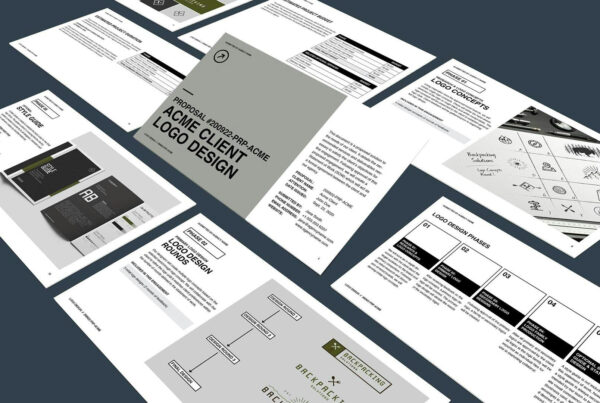What is a “pitch meeting?” For the sake of this article, let’s agree that a “pitch meeting” is a formal opportunity for you to sit in front of a potential client, to have a meaningful conversation about their business challenges and then position yourself as a solution to the problems they face. Sometimes a “pitch meeting” will happen during an informal conversation For example, an informal “pitch meeting” could evolve out of a one on one conversation with a potential client at an event. Other times, a “pitch meeting” will be a formal conversation in a board room with five or more members of the clients C-level team. Either way, the “pitch meeting” is an opportunity for you to showcase yourself as a solution to a client’s business problem. Be ready.
 Before we dig into some tips let me make this clear, I do not believe in pitching ideas, designs, strategies or any other free thoughts or work in an effort to win a project from a client. I’ve done it. It never worked. I’ve presented solutions and designs to potential clients in an effort to “show our abilities” in hopes to win an engagement. In my recollection, we never won. All the pitched free work did was disqualify us or provide the client with results for free.
Before we dig into some tips let me make this clear, I do not believe in pitching ideas, designs, strategies or any other free thoughts or work in an effort to win a project from a client. I’ve done it. It never worked. I’ve presented solutions and designs to potential clients in an effort to “show our abilities” in hopes to win an engagement. In my recollection, we never won. All the pitched free work did was disqualify us or provide the client with results for free.
The reasons you don’t want to pitch free solutions are twofold. First, you should be paid for your expertise. Don’t give away the magic. And second, it rushes the process. At the “pitch” phase of a sales process, you typically don’t know enough about the client’s problem to provide effective results (design and strategy).
I do, however, believe in pitching the process you will use to produce results for your client. If you’ve taken my freelance course, you’ll know how to do that in-depth. In this article, let’s run through the mindset, preparation and meeting flow you should use to standout and win during your next opportunity to pitch a potential client.
Prepare for the Pitch
Do research and prepare for the meeting. If you can’t find some of these answers (or at least assume the answers from your research) then the potential client isn’t getting their story out there very well (which could be an opportunity for you to help them). Or you didn’t do enough research or make smart assumptions. Look for holes in their brand and marketing efforts.
1. Research the client.
- How long have they been in business?
- Where do they market themselves?
- How big are they?
- How big are their marketing/social media channels?
- How big are their marketing/social channels?
- Who is their target audience?
- Who are the key people at the company?
- Soak up all the info you can about their company.
2. Research the client’s competitors.
- Who are their top two or three competitors?
- How long have their competitors been in business?
- Where do their competitors market themselves?
- How big are their competitors?
- How big are their competitor’s marketing/social channels?
- Who are the main people at their competitor’s companies?
- What are competitors strengths and weaknesses compared to the potential client?
Understanding their competitors will help you have an effective conversation with the potential client.
3. Research the client’s industry.
- Do a few Google searches and see if there is anything happening in their industry that may be affecting them.
4. Make presentation decks.
- Don’t go in a pitch meeting empty handed. There is no such thing as a “meet and greet.” Every interaction with a potential client is an opportunity to sell.
- Assume what services they will need and depending on the sales phase you are in, you can either make an official proposal that you’ll present to the client, or you’ll craft a generic pitch deck that shows the general process you’ll use for the types of services they need.
- Make another presentation deck with case study examples of similar work you’ve done for other clients. (Bonus points for focusing your examples on the results you generated for the client.)
During the Pitch Meeting
Show up to the meeting five minutes early. The meeting can be face to face or on a video call, either option is totally acceptable. Put a smile on your face and be confident. You’ve done your research. You understand the client as well as possible at this stage of the sales process. You’re ready. With research completed, you are prepared to talk with them about their industry, business, competitors and their needs.
1. Talk about them.
- “We did some research and looked at some of your competitors? What do you think _________ competitor does more effectively than you? Less effectively than you?
- “We saw this change happening in your industry _________. What impact has it had on your business?”
- “Can we talk about the big picture problem you’re trying to solve? We understand this to be the problem _________. What ways have you done to try solving it before? What results did those efforts yield?”
- Ask smart questions and talk about them.
2. Transition to positioning yourself as the solution.
- “This has been super helpful information for us. We are confident that we can be a great fit to you help your business. Could we walk you through a couple things for 10 minutes, or so?”
- Pitch your process. Walk the client through your services deck or proposal. Don’t make it long (8 to 10 minutes). Highlight yourself as the solution to their problem and show them the process you will use to solve it.
3. Prove that you can do it.
- Walk the potential client through a couple of case study examples showing the impact you have had on other clients. The closer the examples can be to the potential client, the better. (i.e. Don’t show a potential bank client examples of work you did for a pizza restaurant (unless that is all you have to show).
4. Close the pitch discussing next steps.
- “Thanks so much for your time. This has been great. When do you think you’ll make a decision? Do you mind if I follow up in ____ days to see if you have any questions?”
After the Pitch
When the pitch meeting is over, we don’t hide behind our computer, checking email ever 47 seconds to wait for the client to notify us that we won. No no. We actively follow up and create more touch points with the client until we are officially selected or denied.
1. Send them a “thank you” email.
Include a PDF version of the presentation you showed during your meeting.
2. Follow up
You set expectations for the follow up in the meeting. Now do it.
3. Resolve their concerns.
This may take a few conversations, but you need to identify and resolve any concerns they have. You may need to adjust the scope, revise the price or pitch other people in thei company.
Like the Boy Scout motto recommends, “be prepared.” Prepare through research. Prepare for an effective meeting. And prepare to follow up. The advice listed in this article works. It is “sales” and if you want to grow your creative business (or even sustain it, for that matter) you need to sell.












